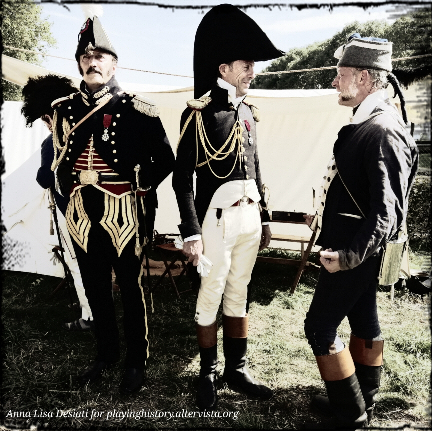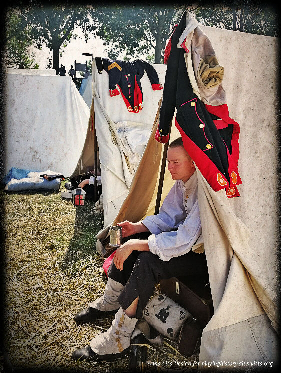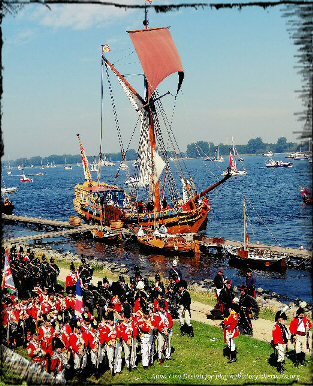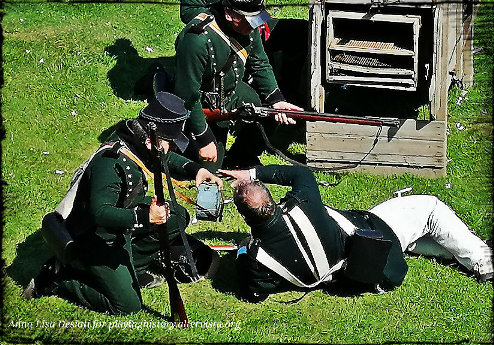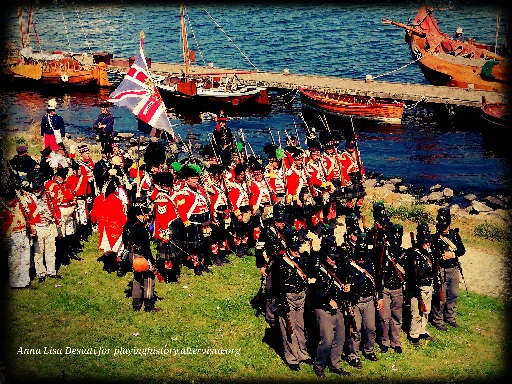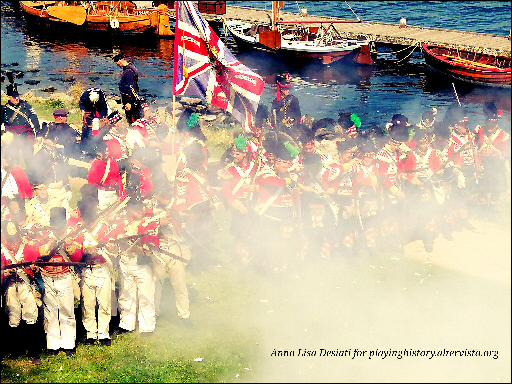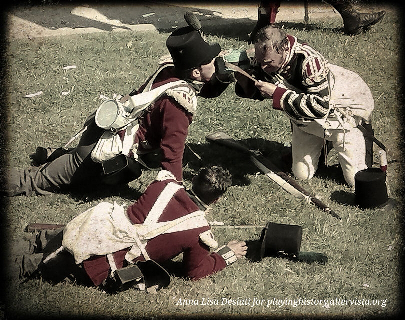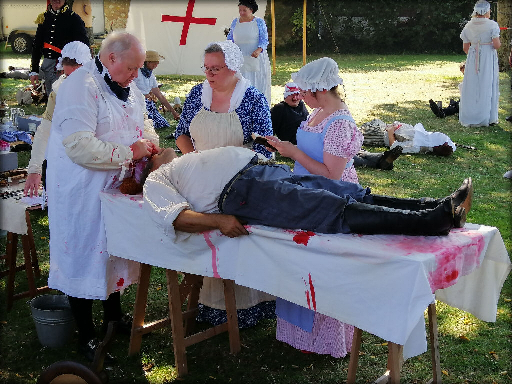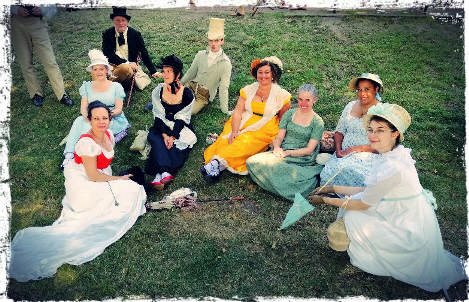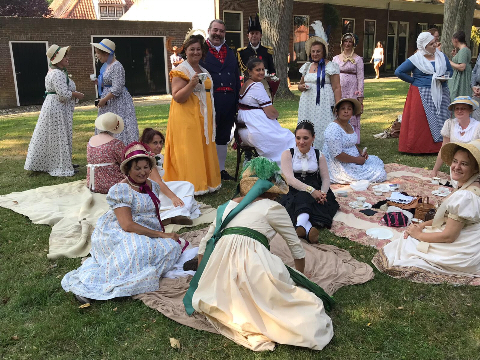Veere 1819, Regency Civilian weekend
Veere is a small town with a population of around 1,500 situated in South West Netherlands, in the region of Walcheren in the province of Zealand. Nowadays, it is a popular tourist destination consisting of narrow streets and charming local shops surrounded by a small harbour. Veere’s natural beauty coupled with its slow-pace lifestyle make it an ideal place for a relaxing holiday.
In August
2019, a re-enactment event was held to commemorate the 210 th anniversary of
the Walcheren Campaign of 1809. At that time, Veere was a small village on the
former island of Walcheren used as a port by local fishermen and wool traders.
In the first part of the nineteenth century, the leading Province of Holland
was set by Napoléon Bonaparte as a Kingdom, and his brother Ludovic was
appointed its king. During this time, the British wanted to prevent the port of
Antwerp being used as a base against them so they planned to attack and conquer
Walcheren in order to have access to the other ports in the South. On July 30
th , 1809, the British launched their first attack and with little effort they
were able to seize control over the island of Walcheren.
However, soon after, the British troops began to suffer from malaria popularly dubbed
as “Walcheren fever”, causing them to leave the Island abruptly by the end of
the year, due to heavy losses from the sickness.
The
historical re-enactment which included both military and civilian impressions,
was one of the highlights of this year’s calendar of events. As a Captain of
the Grande Armèe I was stationed in the field encampment close to the General
within the shade of the Grote Kerk. The first meeting of these three days of
historic re-enactment was a trip in full uniform on ‘De Utrecht’, a ship which
is an exact replica built on the 1746 original designs. When I embarked on the
ship, accompanied by some noble women, we were joined by the other officers and
guests. The ship’s captain welcomed us on board and showed us around whilst
pointing out to us some of the ship’s main features. The idea behind this
‘voyage’ was to experience how sea travelling occurred in those days. Once we
had moved away from the pier, some of us had the opportunity to help the
sailors to hoist the sails hoping for the wind to be able to sail, but unfortunately
there was no wind at all! In the afternoon I was present for the dance workshop
which was in preparation for the following day’s Grand Ball.
When this was over, I went to the tavern to meet the other officers, where we drank
until late at night.
The next day we went to Middelburg, where we not only visited the very interesting Town Hall but also had the opportunity to discover the history and culture of this locality through a guided tour of the city. In the early evening, we had time to prepare ourselves for the Grand Ball which for many was the highlight of the whole event. The sun was setting and the eagerly anticipated moment arrived: the ladies who were eager to show off their new clothes made of fine fabrics, while the gentlemen and officers clad in their superb uniforms, were trying to capture the demure looks of some beautiful lady. The Grand Ball was held in the most beautiful chamber of the city’s Town Hall which is one of the best examples of gothic architecture throughout the Netherlands. Once inside the hall, and after having taken off the sword and the bicorn, I dashed straight to a noble woman from Rome and asked her if she would grant me the honour of dancing with her for the opening of the Ball. Dancing commenced under the watchful eye of the dance master; a musical quartet was in attendance.
During the
entire evening, one could see that some of those present danced tirelessly,
whilst others, tasted the delicacies provided by the excellent cooks who
prepared all the food by following period recipes. Other guests paused in front
of some window hoping that they could enjoy some cool August evening breeze.
Others indulged in gossip. The evening was so enjoyable that we did not realise
that time had passed so quickly and that the Grand Ball had come to an end.
Early the next morning, I was awakened by the sound of drums to commence the
preparations of the re-enactment of the naval attack on the fortress which was
being defended by the French and Dutch soldiers. The re-enactors present for
the battle arrived from different parts of the world: France, Germany, Italy,
Spain, Scotland, Malta, England, Australia and Canada, though there were
obviously many who were from the Netherlands. The first shots were fired in the
afternoon from the British galleon. The large number of cannons on land
retaliated and succeeded in controlling the British advance. I myself as one of
the aide-de-camps to the General, had the duty of forwarding orders to the various
sergeants during the battle movements within the French battalion. This strategic
position was soon lost as the British marines landed from various parts of the
shore and they gradually succeeded in seizing control of the Dutch battery. The
arrival of more French troops was not enough to offset the British assault and
so the Dutch and the French troops had no alternative but to surrender.
Having participated in this historic commemoration, was not only an emotional
occasion because I shared this event with old and new friends in re-enactment,
but also because I could relive the military aspect of the battle of Sunday
afternoon and participate in the various activities for civilian re-enactors.
Reportage by Noel Bezzina
Photos by Anna Lisa Desiati for Playing History
***
Veere, un piccolo paese Olandese vicino al mare di circa 1500 abitanti, è una località turistica che vanta un moderno porticciolo turistico circondato da stradine e localini caratteristici. La bellezza naturale del posto accompagnata dai ritmi lenti è lo sfondo ideale per una vacanza rilassante.
Lo
scorso agosto si è tenuta un’importante rievocazione storica che ha commemorato
i 210 anni della Campagnia di Walcheren.
In quei tempi Veere era un paesino sull’isola di Walcheren con un porto sicuro
per il commercio della lana e per i pescatori locali. All’inizio dell’ottocento
l’Olanda faceva parte dell’impero Francese e l’imperatore Napoleone Bonaparte
designò suo fratello Ludovico come re.
In quell’epoca, gli inglesi, bisognosi di porti sicuri nel sud, pensarono di attaccare
Walcheren e conquistarla per avere l’accesso agli altri porti olandesi. Veere
era ben fortificata e ben protetta dai soldati sia olandesi che francesi. Il
primo colpo di cannone fu sparato su Veere durante l’estate, esattamente il 30
luglio del 1809.
Alla fine la cittadina fu conquistata dagli inglesi, ma poco dopo questi ultimi furono colpiti dalla malaria soprannominata “ Febbre di Walcheren” che li costrinse a lasciare l’isola prima della fine dell’anno.
Oltre all’aspetto militare di questa ricostruzione storica c’era anche la presenza civile che completava la kermesse storica tra le più attese di quest’anno. Come Capitano della Grande Armée avevo la mia sistemazione nell’accampamento francese vicino al Comandante, sotto l’ombra della chiesa di Grote. Il primo appuntamento dei tre giorni di questa rievocazione storica è stata la gita in abito d’epoca sul vascello “De Utrecht”, una riproduzione accurata del modello originale del 1746.
Salito
sull’imbarcazione in compagnia di alcune nobildonne, ci siamo uniti ad altri
ufficiali ed ospiti.
Il capitano ci ha dato il benvenuto a bordo e ci ha illustrato alcune caratteristiche
del vascello. Lo scopo di questa escursione era quella di farci capire come si
viaggiava sulle imbarcazioni di quell’epoca. Una volta lontani dal molo alcuni
di noi hanno avuto l’opportunità di aiutare i marinai nell’issare le vele per
poter navigare grazie al vento, peccato che non c’era vento...
Di pomeriggio ho partecipato al laboratorio di danza in preparazione del gran ballo del giorno successivo. Una volta terminato, mi son recato nell’accampamento per raggiungere gli altri ufficiali in taverna dove 4abbiamo bevuto sino a tarda notte.
Il giorno successivo ci siamo spostati nella cittadina di Middleburg dove non solo abbiamo fatto un’interessantissima visita al Municipio ma abbiamo avuto l’opportunità di scoprire la storia e la cultura di questo luogo attraverso una passeggiata guidata della città. Rientrati dal dalla passeggiata della città abbiamo incominciato a prepararci per la parte culminate della giornata, ovvero il Gran Ballo.
Finalmente il momento più atteso dalle gentildonne: il ballo! Tutte smaniose di mostrare i loro nuovissimi abiti dai tessuti fluidi e pregiati, mentre i gentiluomini e gli ufficiali si mostravano nelle loro splendide divise per catturare gli sguardi discreti di qualche bella dama. Il ballo si è tenuto nella sala più bella del Municipio della città, uno dei migliori esemplari di architettura gotica di tutta l’Olanda!
Una volta entrato nella splendida sala da ballo e dopo essermi tolto la spada ed il bicorno, ho chiesto l’onore di ballare ad una nobildonna di Roma. Le danze si sono aperte sotto la guida attenta del dancemaster accompagnato dalle note del quartetto musicale. Durante l’intera serata mentre alcuni danzavano instancabilmente, altri degustavano delle prelibatezze offerte dai bravissimi cuochi che avevano preparato tutto seguendo ricette dell’epoca. Un’altra parte degli ospiti sostava davanti a qualche finestra nella speranza di godere di un fresco venticello pomeridiano d’agosto; altre si lasciavano andare a pettegolezzi. La serata è stata talmente piacevole che non ci siamo accorti del passar delle ore e del fatto che il ballo era giunto al termine.
La mattina presto mi son svegliato al suono dei tamburi per incominciare i preparativi della ricostruzione dell’attacco navale alla fortezza difesa da noi francesi affiancati dai soldati olandesi. I rievocatori presenti in questa battaglia arrivavano da diverse parti del mondo: Francia, Germania, Italia, Spagna, Scozia, Malta, Inghilterra, Australia, Canada e ovviamente erano presenti anche gli olandesi. I primi colpi vennero sparati dalla nave inglese nel primo pomeriggio; ad essi risposero numerosi cannoni a terra, riuscendo così a controllare l’avanzata inglese. Essendo uno degli aiutanti del comandante avevo il compito di rilasciare le comunicazioni ai vari sergenti durante le manovre del reggimento francese. La posizione strategica delle truppe terrestri fu presto persa in quanto i Marines riuscirono a sbarcare in diversi punti della costa riuscendo gradualmente a prendere il controllo della batteria olandese. L’arrivo dei rinforzi dei granatieri francesi non fu sufficiente per neutralizzare l’attacco inglese e alle truppe olandesi e francesi non rimase che arrendersi.
Partecipare a questa rievocazione storica è stato molto emozionante, non solo perché ho condiviso questi momenti con vecchi e nuovi amici rievocatori, ma anche perché ho potuto rivivere l’aspetto militare durante la battaglia di domenica pomeriggio e partecipare alle varie attività civili.
Reportage di Noel Bezzina
Foto di Anna Lisa Desiati per Playing History
